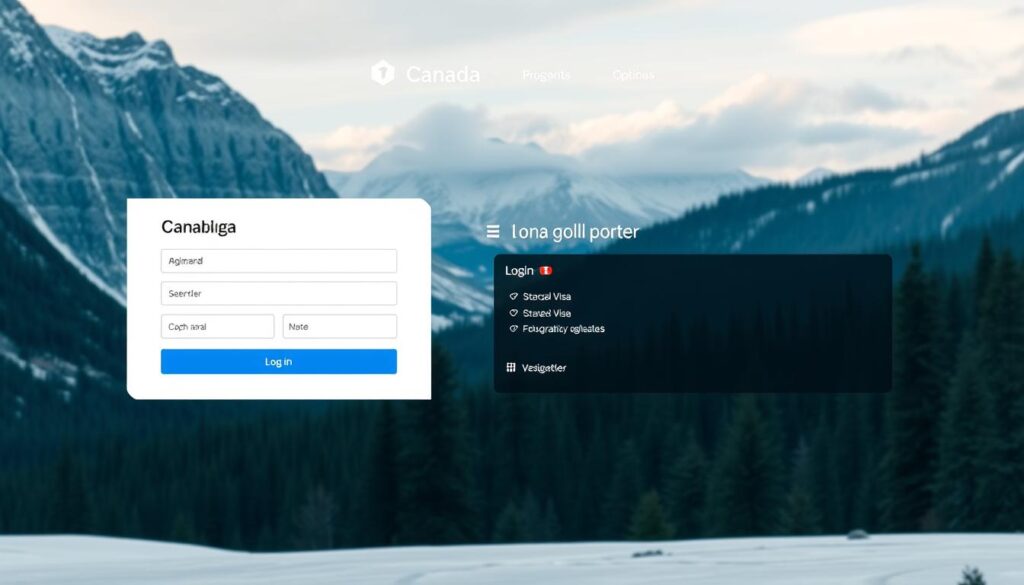Canada plans to welcome over 500,000 new permanent residents by 2025 – a number larger than the population of Halifax. This ambitious target reflects the country’s commitment to building diverse communities while addressing labour market needs. If you’re considering making this move, understanding your pathway matters now more than ever.
Permanent residency grants you the legal right to establish your life here indefinitely while keeping your original citizenship. You’ll access healthcare, education, and social services just like Canadian citizens. However, you must meet specific residency requirements to maintain your status over time.
The journey begins with proper documentation. Official proof of status serves as your golden ticket to employment opportunities and public benefits. Unlike temporary visas, this status removes expiration dates from your Canadian dreams – provided you follow the rules.
Navigating the process requires reliable tools. The Canada visa portal acts as your digital compass, offering application tracking, policy updates, and step-by-step guides. Whether you’re applying through economic programs or family sponsorship, this platform keeps you informed at every stage.
Key Takeaways
- Permanent residency offers indefinite living rights without citizenship renunciation
- Residency obligations require physical presence in Canada for 730 days every 5 years
- Government documentation proves your status for work, travel, and benefit access
- The official immigration portal provides real-time application updates
- Economic and family programs serve as primary pathways to status approval
Introduction to Residente Permanente Canada
Canada’s permanent residency offers a pathway to live, work, and study across the country indefinitely. This status bridges temporary visas and full citizenship, providing stability while preserving your original nationality.
What Permanent Residency Means for You
As a permanent resident, you gain rights to healthcare coverage, public education, and most social programs. You can pursue employment in any province without needing employer-specific permits. Unlike temporary visas, this status doesn’t expire if you meet residency obligations.
After living in Canada for 1,095 days within five years, you become eligible to apply for citizenship. This requires passing language tests, demonstrating knowledge of Canadian values, and taking the Oath of Citizenship.
Your Digital Immigration Toolkit
The Canada visa portal transforms complex processes into manageable steps. This centralized platform lets you:
- Submit applications electronically
- Track real-time updates
- Upload required documents securely

Through this portal, you receive direct communication from immigration authorities. It simplifies renewing your PR card, checking processing times, and accessing official guides. Regular updates ensure you never miss critical deadlines or policy changes affecting your status.
While permanent residency grants many citizen-like privileges, it excludes voting rights and some government jobs. Understanding these distinctions helps you plan your long-term goals in Canada effectively.
Understanding Eligibility Requirements for Permanent Residency
Maintaining your status involves meeting specific physical presence rules that balance flexibility with accountability. These requirements ensure you contribute to Canadian society while preserving your ability to pursue opportunities abroad temporarily.
![]()
Residency Obligations and Minimum Stay Requirements
You must accumulate 730 days in the country within any five-year window. These days don’t need to be consecutive, allowing for work trips, family visits, or personal travel. The clock starts ticking the day you receive your status.
Certain exceptions count toward your total. Time spent abroad with a Canadian spouse or working for a domestic employer may qualify. The Canada visa portal offers calculators to help track eligible days automatically.
Failing to meet obligations risks losing your status. Immigration officers review entry/exit records during renewal applications. Keep copies of boarding passes, rental agreements, and employment contracts as proof of residence.
Use the government portal’s dashboard to monitor your progress. It flags potential shortfalls early, giving time to adjust plans. Regular updates ensure you follow evolving policies affecting your eligibility.
Required Documentation for Your Application
Proper documentation acts as the foundation of your journey to secure permanent residency. Gathering accurate records demonstrates your eligibility and streamlines approval processes. Let’s break down what you’ll need.
Essential Documents and Proof of Status
Your application requires identity verification, proof of financial stability, and background checks. The Confirmation of Permanent Residence (COPR) becomes your interim status proof after approval. This document lets you:
- Apply for a Social Insurance Number
- Access provincial healthcare
- Enroll in government services

Keep physical and digital copies of your COPR until your PR card arrives. Immigration authorities cross-reference these records during status verification.
Confirmation of Permanent Residence and PR Card
Most cards remain valid for five years, aligning with standard renewal cycles. “Your PR card isn’t just ID – it’s your key to seamless re-entry into Canada,” notes an immigration advisor. Those under status review might receive one-year validity cards.
The Canada visa portal simplifies document management. Upload files directly, track submissions, and receive instant updates. Renewal reminders appear automatically, helping you maintain continuous status.
Navigating the Application Process
Submitting your permanent residency application becomes manageable when using the government’s digital tools effectively. The Canada visa portal transforms complex procedures into clear, actionable steps while minimizing errors through built-in validation checks.

Step-by-Step Guide to Applying
Begin by confirming your eligibility through the portal’s self-assessment tool. This feature matches your profile with suitable immigration programs, saving weeks of research. You’ll then receive a personalized checklist outlining required documents like language test results and financial proofs.
Payment strategies impact processing timelines significantly. While the Right of Permanent Residence Fee ($490 CAD) can be paid post-approval, combining it with your initial application fee prevents delays. “Double payments get refunded automatically if your application fails,” confirms an immigration officer via the portal’s help section.
Tips to Avoid Common Application Pitfalls
Missing signatures or expired passports top the list of rejections. Use the portal’s document scanner to verify each file meets specifications before uploading. Set calendar reminders for medical exams and police certificates – these time-sensitive items often expire during lengthy processing periods.
The platform’s real-time tracker alerts you when action is required. Respond promptly to requests for additional information to keep your application moving forward. Regular updates ensure you never miss critical deadlines that could reset your place in the queue.
Insights into the PR Card Process
Your proof of status evolves alongside border security needs. Since 2002, three distinct versions have shaped how residents confirm their legal standing. The Canada visa portal displays current requirements and historical changes for each iteration.
Overview of PR Card Versions and Features
The 2015 model introduced RFID chips for faster U.S. border crossings. This technology allows pre-screening before reaching inspection booths. Older versions remain valid until expiration but lack modern security layers.
| Version | Key Feature | Active Until |
|---|---|---|
| 2002 | Basic holographic elements | Phased out |
| 2009 | Enhanced UV patterns | Natural expiration |
| 2015 | Encrypted RFID chip | Current standard |
Understanding Fees and Processing Timelines
A flat $50 CAD fee applies to all card services. Payments through the portal’s secure system trigger immediate receipts. Most applications process within 45 days, though summer peaks may extend waits.
Provide a Canadian address within 180 days of arrival. Delays risk card delivery issues and status complications. The portal’s address update tool ensures real-time synchronization with immigration databases.
Renewal alerts appear 6 months before expiry. Track progress through personalized dashboards showing document verification stages. Lost cards require sworn statements but follow the same fee structure.
Maintaining Your Permanent Residency Status
Keeping your status active requires strategic planning and consistent monitoring. The 730-day residency rule allows flexibility but demands accurate record-keeping to avoid complications during border crossings or renewal applications.
![]()
Smart Tracking Through Digital Tools
The government portal simplifies compliance with automatic day counters and personalized dashboards. Log in to view:
- Accumulated physical presence days
- Projected compliance timelines
- Alerts for upcoming travel risks
Special circumstances may count toward your requirement. Time spent outside Canada while employed by a domestic company or accompanying a citizen family member often qualifies. Maintain pay stubs, contracts, or marriage certificates as proof.
| Scenario | Eligible Days | Required Proof |
|---|---|---|
| Working abroad for Canadian employer | Full duration | Employment letter, tax filings |
| Spouse’s international assignment | Up to 730 days | Marriage certificate, partner’s citizenship proof |
| Humanitarian reasons | Case-by-case | Medical records, official appeals |
Border officers verify residency through entry stamps, lease agreements, and utility bills. Update your address promptly using the portal’s secure form to ensure accurate record-keeping.
Those falling short may face hearings to justify their absence. Regular portal check-ins help identify gaps early, allowing time to adjust travel plans or gather supporting evidence.
Rights and Responsibilities of a Canadian Permanent Resident
Holding permanent residency status creates a unique balance of opportunities and obligations. While enjoying many privileges similar to citizenship, you’ll need to follow specific rules to maintain your status over time.
Access to Social Benefits and Health Care Services
Your status grants access to universal healthcare through your province or territory. Coverage begins after meeting regional residency requirements, typically three months. “Healthcare access remains one of the most valued benefits,” states an official portal guide.
You contribute to social programs like:
- Canada Pension Plan
- Employment Insurance
- Provincial worker compensation
These benefits mirror those available to citizens, creating financial safety nets during unemployment or retirement.
Restrictions and Limitations on Voting and Employment
While you can work freely across industries, certain roles remain off-limits. Jobs requiring high-level security clearances exclude permanent residents due to national security protocols. The Canada visa portal lists restricted positions in both public and private sectors.
Political participation comes with clear boundaries:
- No voting in federal/provincial elections
- Cannot run for public office
- Ineligible for jury duty
Transitioning to Canadian citizenship removes these limitations. Until then, focus on maintaining residency requirements through the portal’s tracking tools while enjoying your current rights.
Living the Canadian Permanent Resident Life
Your new journey involves exploring regional opportunities while maintaining status requirements. The freedom to choose where you live becomes one of the most exciting aspects of permanent residency. From bustling cities to coastal towns, each area offers unique advantages for building your future.
Adapting to Regional Opportunities
The Canada visa portal simplifies settling into your chosen province or territory. Customized guides provide local insights on housing markets, school systems, and employment trends. Interactive maps highlight cultural hotspots and essential services near your new community.
Access regional job boards directly through the platform. Many provinces offer residency support programs for skilled workers in high-demand fields. Language training modules adapt to local dialects, helping you communicate confidently in professional settings.
Track your physical presence requirements while exploring different areas. The portal’s compliance calculator updates automatically as you move between provinces. This ensures you maintain status while discovering the best way to establish roots in your preferred region.
Regular policy updates keep you informed about province-specific benefits. Whether accessing healthcare in Ontario or starting a business in British Columbia, tailored resources make adaptation smoother. Your Canadian permanent status unlocks endless possibilities – the portal helps you navigate them all.



